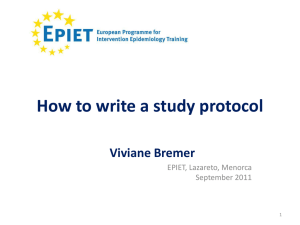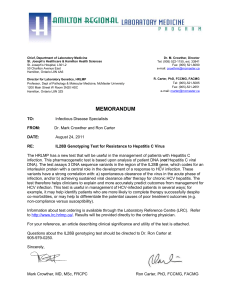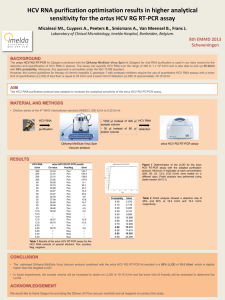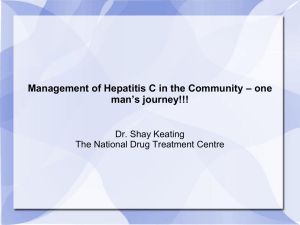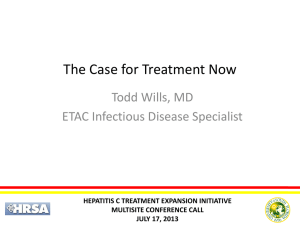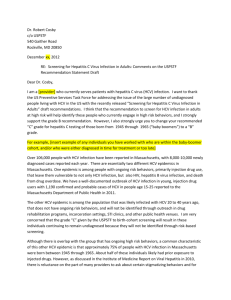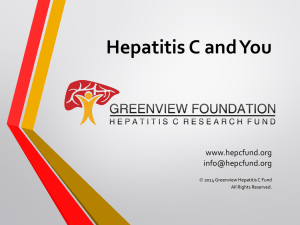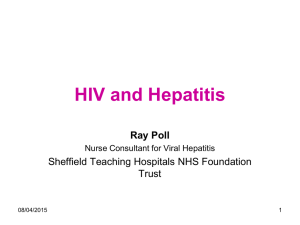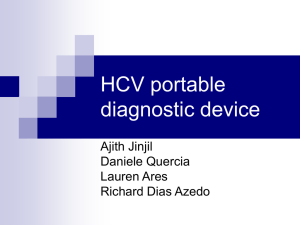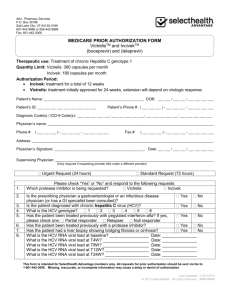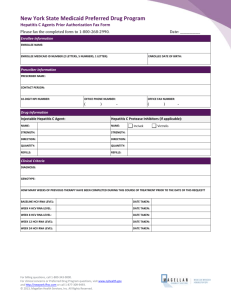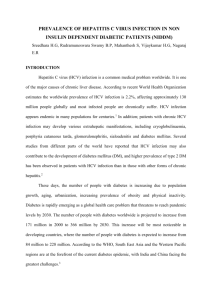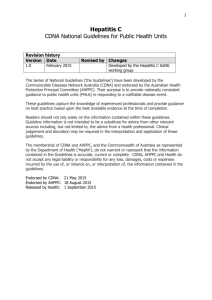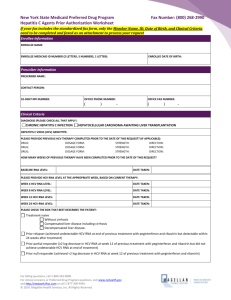Administrative Office St. Joseph`s Hospital Site, L301
advertisement
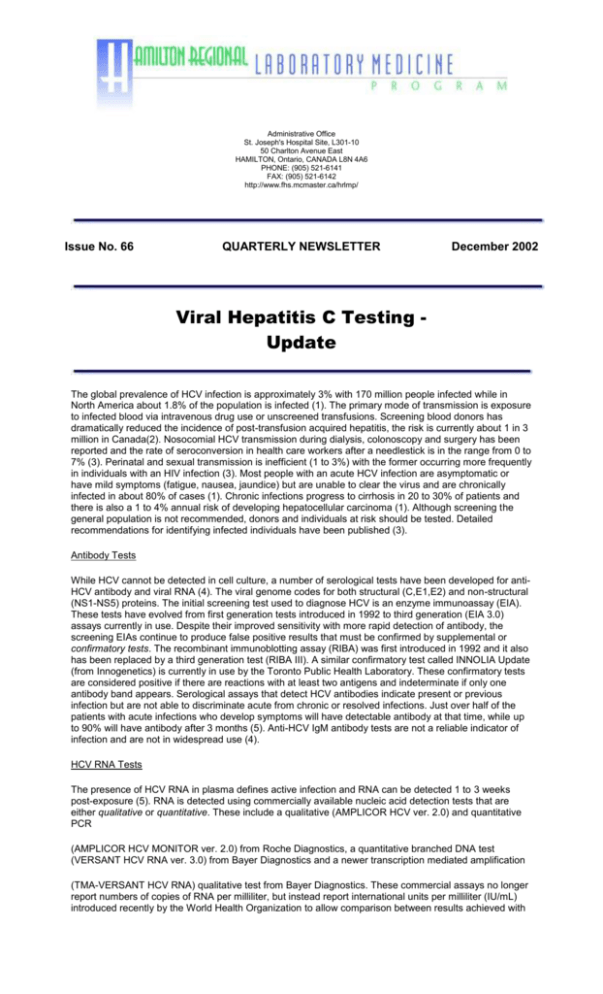
Administrative Office St. Joseph's Hospital Site, L301-10 50 Charlton Avenue East HAMILTON, Ontario, CANADA L8N 4A6 PHONE: (905) 521-6141 FAX: (905) 521-6142 http://www.fhs.mcmaster.ca/hrlmp/ Issue No. 66 QUARTERLY NEWSLETTER December 2002 Viral Hepatitis C Testing Update The global prevalence of HCV infection is approximately 3% with 170 million people infected while in North America about 1.8% of the population is infected (1). The primary mode of transmission is exposure to infected blood via intravenous drug use or unscreened transfusions. Screening blood donors has dramatically reduced the incidence of post-transfusion acquired hepatitis, the risk is currently about 1 in 3 million in Canada(2). Nosocomial HCV transmission during dialysis, colonoscopy and surgery has been reported and the rate of seroconversion in health care workers after a needlestick is in the range from 0 to 7% (3). Perinatal and sexual transmission is inefficient (1 to 3%) with the former occurring more frequently in individuals with an HIV infection (3). Most people with an acute HCV infection are asymptomatic or have mild symptoms (fatigue, nausea, jaundice) but are unable to clear the virus and are chronically infected in about 80% of cases (1). Chronic infections progress to cirrhosis in 20 to 30% of patients and there is also a 1 to 4% annual risk of developing hepatocellular carcinoma (1). Although screening the general population is not recommended, donors and individuals at risk should be tested. Detailed recommendations for identifying infected individuals have been published (3). Antibody Tests While HCV cannot be detected in cell culture, a number of serological tests have been developed for antiHCV antibody and viral RNA (4). The viral genome codes for both structural (C,E1,E2) and non-structural (NS1-NS5) proteins. The initial screening test used to diagnose HCV is an enzyme immunoassay (EIA). These tests have evolved from first generation tests introduced in 1992 to third generation (EIA 3.0) assays currently in use. Despite their improved sensitivity with more rapid detection of antibody, the screening EIAs continue to produce false positive results that must be confirmed by supplemental or confirmatory tests. The recombinant immunoblotting assay (RIBA) was first introduced in 1992 and it also has been replaced by a third generation test (RIBA III). A similar confirmatory test called INNOLIA Update (from Innogenetics) is currently in use by the Toronto Public Health Laboratory. These confirmatory tests are considered positive if there are reactions with at least two antigens and indeterminate if only one antibody band appears. Serological assays that detect HCV antibodies indicate present or previous infection but are not able to discriminate acute from chronic or resolved infections. Just over half of the patients with acute infections who develop symptoms will have detectable antibody at that time, while up to 90% will have antibody after 3 months (5). Anti-HCV IgM antibody tests are not a reliable indicator of infection and are not in widespread use (4). HCV RNA Tests The presence of HCV RNA in plasma defines active infection and RNA can be detected 1 to 3 weeks post-exposure (5). RNA is detected using commercially available nucleic acid detection tests that are either qualitative or quantitative. These include a qualitative (AMPLICOR HCV ver. 2.0) and quantitative PCR (AMPLICOR HCV MONITOR ver. 2.0) from Roche Diagnostics, a quantitative branched DNA test (VERSANT HCV RNA ver. 3.0) from Bayer Diagnostics and a newer transcription mediated amplification (TMA-VERSANT HCV RNA) qualitative test from Bayer Diagnostics. These commercial assays no longer report numbers of copies of RNA per milliliter, but instead report international units per milliliter (IU/mL) introduced recently by the World Health Organization to allow comparison between results achieved with different assays (6). The qualitative AMPLICOR HCV test (ver. 2.0) has a detection limit of 50 IU/mL and the quantitative assay a detection limit of 500 IU/mL. The Toronto PHL uses both the AMPLICOR HCV qualitative and AMPLICOR HCV MONITOR quantitative tests. Qualitative RNA tests are used to establish infection/infectivity, to confirm EIA screening or RIBA indeterminate results, to confirm infection in immunocompromised patients that fail to seroconvert, and to confirm infection in a newborn that has passively-acquired maternal HCV antibody. A single negative RNA test should be interpreted with caution and cannot exclude infection as some individuals have low levels of viremia that can oscillate below the level of detection of a given assay. Quantitative tests are used to establish baseline pre-treatment levels of virus and to monitor response in individuals treated with antiviral drugs. Requests for viral load and genotyping tests are only performed when accompanied by clinical information viz. either pre-treatment (baseline) or elevated liver enzymes. HCV Genotyping HCV has been divided into 6 major genotypes and over 80 subtypes. Commercial genotyping tests involve hybridization or sequencing methods to assign a genotype. The widely used INNO-LiPA HCV II ver. 2.0 test (Innogenetics) currently used by the PHL uses PCR products obtained by the Roche AMPLICOR for hybridization with genotype-specific probes immobilized on nitrocellulose strips. The INNO-LiPA HCV II genotyping test reports 6 types and 21 subtypes. HCV genotyping is used primarily in management decisions regarding treatment. Treatment for chronic HCV infection has progressed from monotherapy with interferon which gave disappointing sustained virologic response (SVR) rates of only 10-20% (5), to combination therapy with interferon plus ribavirin, which is associated with a higher SVR rate of nearly 40%. Optimal therapy is now considered to be a combination of pegylated interferon plus ribavirin, with reported SVRs of 56%. Successful treatment has been associated with low viral load at baseline, infection with a non-type 1 genotype, absence of cirrhosis, age less than 40 years and female gender (7). Although the incidence of new cases of HCV infections in North America is declining, the population of individuals infected for >20 years who are at risk for serious complications is projected to increase until about 2015. As new therapeutic options emerge and laboratory assays continue to evolve, the clinical relevance and use of laboratory tests for HCV will require frequent reassessments. James B. Mahony, Ph.D., F.A.A.M., F.C.C.M. Head, Regional Virology and Chlamydiology Laboratory St. Joseph's Healthcare References: 1. Lauer, G.M., and B.D. Walker. (2001). Hepatitis C virus infection. N. Engl. J. Med. 345:41-52. 2. Kleinman, S. (2003). Transfusion Medicine Reviews. 17 (2), in press. 3. Centers for Disease Control and Prevention. (1998). Recommendations for prevention and control of hepatitis C virus (HCV) infection and HCV-related chronic disease. Morb. Mortal. Wkly. Rep. 47 (RR-19):1-39. 4. Richter, S.S. (2002). Laboratory assays for diagnosis and management of Hepatitis C virus infection. J. Clin. Microbiol. 40:4407-4412. 5. National Institutes of Health Consensus Development Conference Panel. (1997). Management of hepatitis C. Hepatology 26 (Suppl.1):2S-10S. 6. Pawlotsky, J.-M. et al. (2000). Standardization of hepatitis C RNA quantification. Hepatology 32:654-659 7. Zein, N.N. (2000). Clinical significance of hepatitis C virus genotypes. Clin. Microbiol. Rev. 13:223-235.
